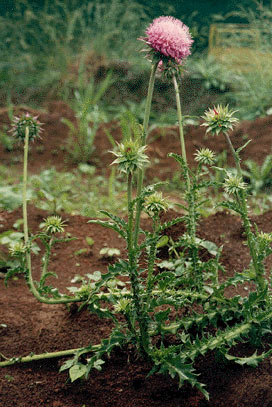- Musk thistle
Taxobox
name = Musk Thistle

image_width = 240px
regnum =Plant ae
divisio =Magnoliophyta
classis =Magnoliopsida
ordo =Asterales
familia =Asteraceae
tribus =Cynareae
genus = "Carduus "
species = "C. nutans"
binomial = "Carduus nutans"
binomial_authority = L.The Musk thistle or Nodding thistle ("Carduus nutans") is a member of the daisy family
Asteraceae . It is a biennialherb with showy red-purpleflower s and sharply spiny stems and leaves. It is native to much ofEurope andAsia except for the far north.Description
Mature plants range in height from 1-1.5 m tall and have multi-branched stems.
The leaves are dark green, coarsely bipinnately lobed, with a smooth, waxy surface and sharp yellow-brown to whitish spines at the tips of the lobes.
The large globose flower heads, containing hundreds of tiny individual
flower s, are 3-5 cm (rarely to 7 cm) diameter and occur at the tips of stems.The flower heads commonly droop to a 90° to 120° angle from the stem when mature, hence its alternate name of "Nodding thistle". Each plant may produce thousands of straw-colored seeds adorned with plume-like bristles.
Musk thistle is usually a biennial, requiring 2 years to complete a reproductive cycle. However, it may
germinate and flower in a single year in warmer climates. Seedlings may emerge at any time from spring to late summer and develop a rosette of large leaves 30-60 cm long. Plants overwinter in the rosette stage, sending up a multi-branched flowering stem in mid spring of their second year.The number of flowerheads per plant is site-dependent and ranges from about 20-50 on good sites and 1-20 on poor sites. Flowering occurs from late spring to late summer, and seed dissemination occurs approximately one month after the flowers form. A single flower head may produce 1,200 seeds and a single plant up to 120,000 seeds, which are wind dispersed. The seeds may remain viable in the soil for over ten years, making it a difficult plant to control.
Musk thistle grows from sea level to an elevation of about 2,500 m in neutral to acidic
soil s. It typically grows on open disturbed soil or heavily grazed land in areas such as meadows, arable land, roadsides, building sites and similar. It spreads rapidly in areas subjected to frequent natural disturbance events such as landslides and flooding, but does not grow well in excessively wet, dry or shady conditions.Cultivation
Musk thistle was introduced into the eastern
North America in the early 1800s and has a long history there as aninvasive species . It has been declared a noxiousweed in many U.S. states and Canadian provinces. Some farmers spend many hours attempting to rid them from farm ground, mostly pastures.External links
* [http://ucjeps.berkeley.edu/cgi-bin/get_JM_treatment.pl?609,867,869 Jepson Manual Treatment]
* [http://plants.usda.gov/java/profile?symbol=CANU4 USDA Plants Profile]
* [http://calphotos.berkeley.edu/cgi/img_query?query_src=photos_index&where-taxon=Carduus+nutans Photo gallery]
Wikimedia Foundation. 2010.
